 As we saw in Part 1, households are seeing a rise in the cost of living, which is set to accelerate. Inflation in the year to January 2022, as measured by the Consumer Prices Index (CPI), was 5.5%, the highest rate for over 30 years, and it is expected to reach more than 7 per cent by April. This has put great pressure on household budgets, with wage rises for most people being below the rate of price inflation. The poor especially have been hard hit, with many struggling to meet soaring energy, food and transport prices and higher rents.
As we saw in Part 1, households are seeing a rise in the cost of living, which is set to accelerate. Inflation in the year to January 2022, as measured by the Consumer Prices Index (CPI), was 5.5%, the highest rate for over 30 years, and it is expected to reach more than 7 per cent by April. This has put great pressure on household budgets, with wage rises for most people being below the rate of price inflation. The poor especially have been hard hit, with many struggling to meet soaring energy, food and transport prices and higher rents.
In Part 2 we look at the UK government’s response to the situation, a similar response to that in many other countries.
Effects on government finances
 The Chancellor, Rishi Sunak, has stated that the government understands the pressures families are facing with the cost of living. However, rising interest rates mean that it will cost the Treasury considerably more to service the UK’s national debt of more than £2tn.
The Chancellor, Rishi Sunak, has stated that the government understands the pressures families are facing with the cost of living. However, rising interest rates mean that it will cost the Treasury considerably more to service the UK’s national debt of more than £2tn.
Interest payments on index-linked debt are calculated using an alternative measure of inflation, the retail prices index (RPI), which is running at 7.8%, considerably higher than anticipated in last October’s Budget. It is now projected that central government spending on debt interest this financial year will come in at around £69bn, some £11bn higher than the £58bn forecast in the October 2021 Budget and £27bn above the £42bn forecast in the March 2021 Budget.
In addition, it is expected that the latest rise in CPI will increase the chances of the Bank of England raising interest rates and thereby further increasing the costs of servicing national debt. If this is the outcome when its Monetary Policy Committee meets next month, then it would be the third successive time interest rates have been raised.
There is also concern that this, in addition to the direct effects of higher costs, will push more firms towards insolvency. It is argued that if government wanted to prevent this, it would need to cut business taxes in order to boost investment and productivity and to allow businesses to provide annual wage rises that are affordable.
Monetary policy
 The Bank of England’s traditional response to rising inflation is to raise interest rates, which it has done this twice in the past few months. This means that people who have borrowed money could see their monthly payments go up, especially on mortgages tied to Bank Rate.
The Bank of England’s traditional response to rising inflation is to raise interest rates, which it has done this twice in the past few months. This means that people who have borrowed money could see their monthly payments go up, especially on mortgages tied to Bank Rate.
An aim of this policy is to make borrowing more expensive resulting in people spending less. As a result, they will buy fewer things, and prices will stop rising as fast. However, when inflation is caused by external forces, this might have a limited effect on prices and would put a further squeeze on household budgets.
Fiscal policy
Alternatively, the government might choose to cut taxes for consumers on items whose prices are rising quickly. It is taking some measures to reduce the impact of energy price rises. For example, the Treasury has announced that it would provide millions of households with up to £350 to help with their rising energy bills and in April the lowest-paid will see the National Living Wage rise by 6.6%, which is higher than the current inflation rate.
The chief economist of the British Chambers of Commerce has said that tightening monetary policy too quickly risks undermining confidence and the wider recovery, arguing that more needs to be done to limit the unprecedented rise in costs facing businesses, including financial support for those struggling with soaring energy bills and delaying April’s national insurance rise.
Conclusion
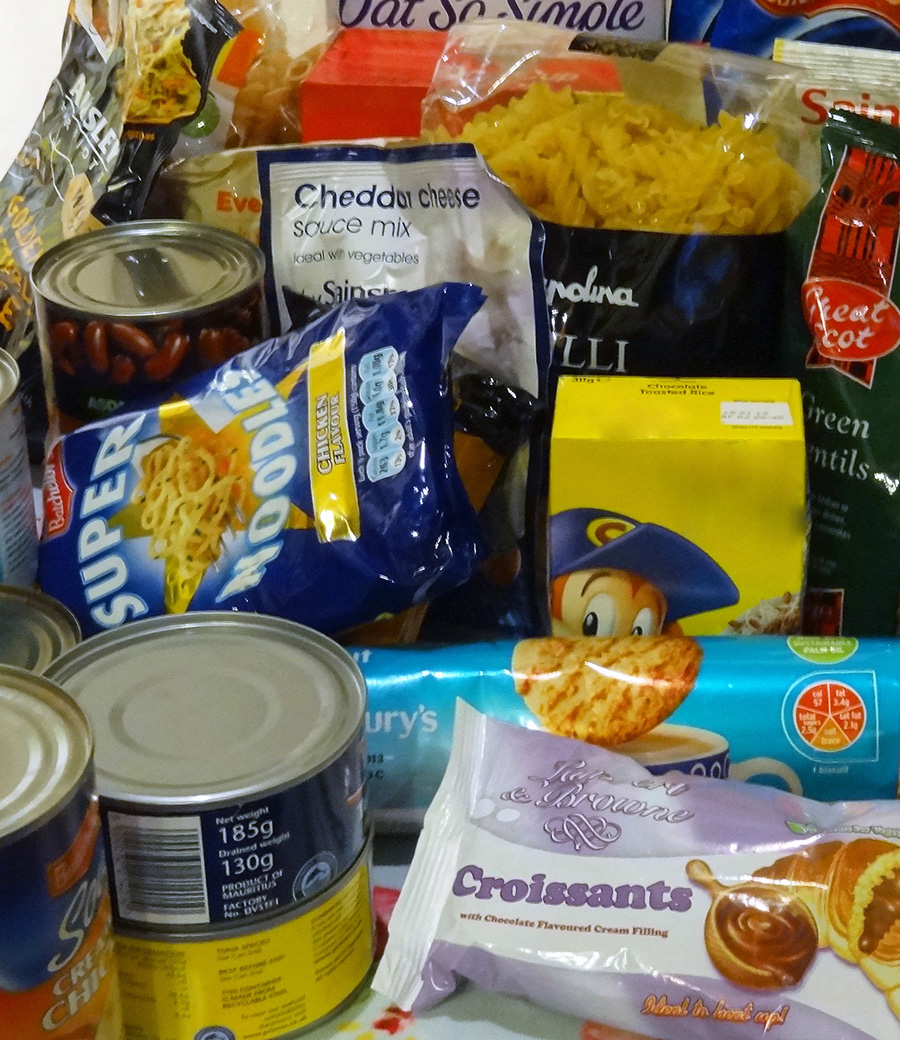 Rising inflation affects all our living standards. It a global issue with causes beyond government control.
Rising inflation affects all our living standards. It a global issue with causes beyond government control.
Rising prices together with planned tax increases mean that real average take-home pay is likely to fall over the coming year. The extra energy costs and tax rises will force families to make savings elsewhere, meaning business revenues may fall, and the economic recovery could be negatively impacted.
However, it is those on low incomes that tend to find it hardest to cope with the rising cost of living. Those impacted the most will be faced with difficult decisions over the coming months as they try to cope with falling real incomes. With food price inflation expected to rise further, a likely rise in interest rates and a further increase in the energy price cap in October, these tough decisions are set to get harder for poorest households in the economy.
Articles
See articles in Part 1
Podcast
Questions
These questions are based on the podcast.
- What elements are there in household energy prices? Which element has gone up most?
- What are the arguments for and against the government delaying the rise in the rate of national insurance by 1.25 percentage points?
- What can be done to help people on modest earnings who earn just too much to receive benefits?
- Are government loans to help people with higher bills a good idea?
- What are the advantages and disadvantages of removing VAT on domestic energy?
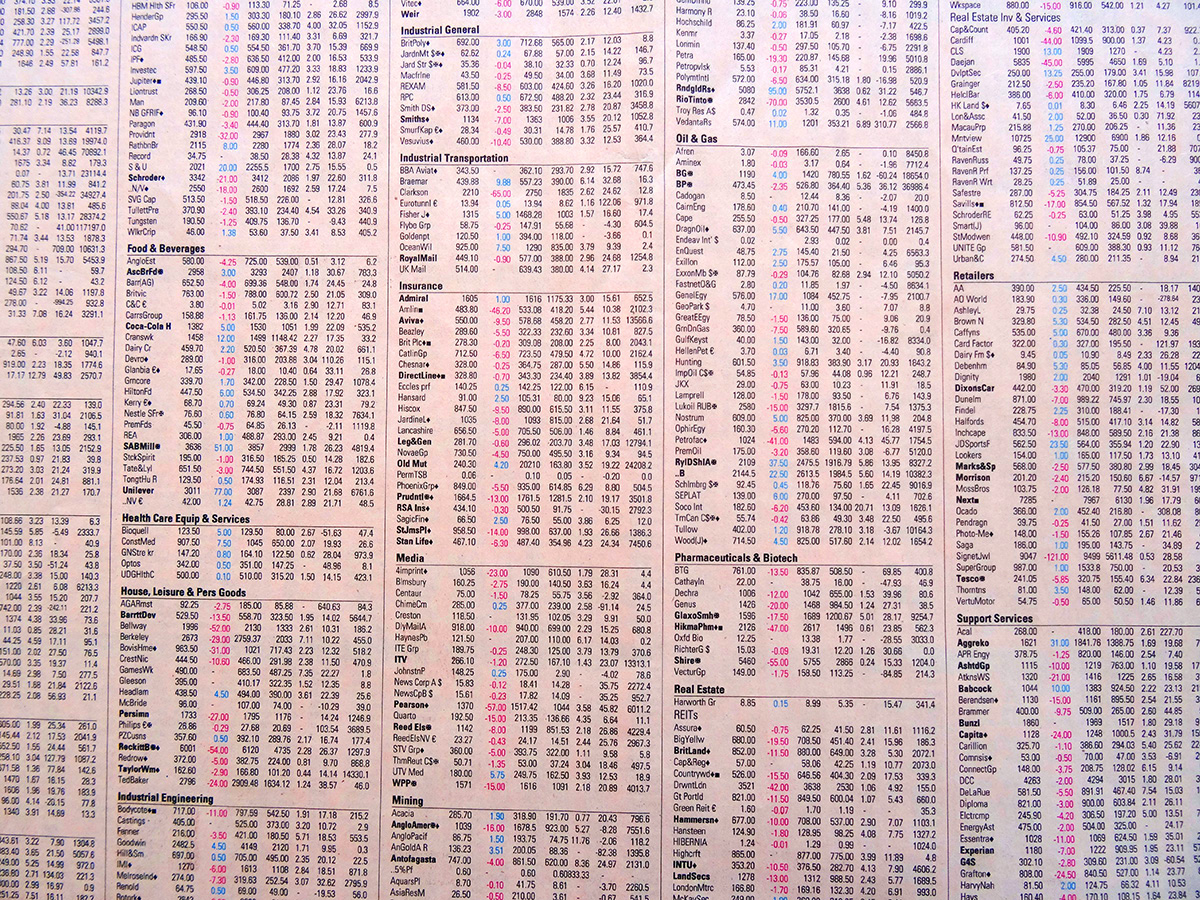 With the onset of the pandemic in early 2020, stock markets around the world fell dramatically, with many indices falling by 30% or more. In the USA, the Dow Jones fell by 37% and the Nasdaq fell by 30%. In the UK, the FTSE 100 fell by 33% and the FTSE 250 by 41%.
With the onset of the pandemic in early 2020, stock markets around the world fell dramatically, with many indices falling by 30% or more. In the USA, the Dow Jones fell by 37% and the Nasdaq fell by 30%. In the UK, the FTSE 100 fell by 33% and the FTSE 250 by 41%.
But with a combination of large-scale government support for their economies, quantitative easing by central banks and returning confidence of investors, stock markets then made a sustained recovery and have continued to grow strongly since – until recently, that is.
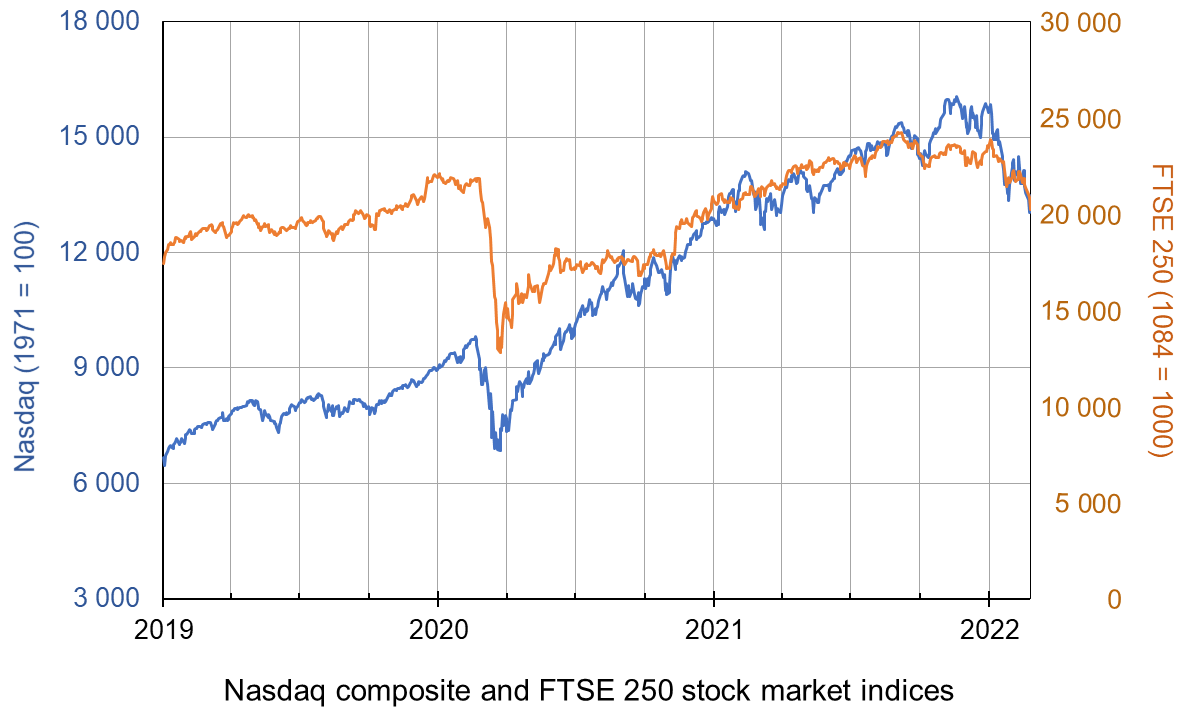
With inflation well above target levels, central banks have ended quantitative easing (QE) or have indicated that they soon will. Interest rates are set to rise, if only slowly. The Bank of England raised Bank Rate from its historic low of 0.1% to 0.25% on 16 December 2021 and ceased QE, having reached its target of £895 billion of asset purchases. On 4 February 2022, it raised Bank Rate to 0.5%. The Fed has announced that it will gradually raise interest rates and will end QE in March 2022, and later in the year could begin selling some of the assets it has purchased (quantitative tightening). The ECB is not ending QE or raising interest rates for the time being, but is likely to do so later in the year.
At the same time economic growth is slowing, leading to fears of stagflation. Governments are likely to dampen growth further by tightening fiscal policy. In the UK, national insurance is set to rise by 1.25 percentage points in April.
The slowdown in growth may discourage central banks from tightening monetary policy more than very slightly. Indeed, in the light of its slowing economy, the Chinese central bank cut interest rates on 20 January 2022. Nevertheless, it is likely that the global trend will be towards tighter monetary policy.
The fears of slowing growth and tighter monetary and fiscal policy have led many stock market investors to predict an end to the rise in stock market prices – an end to the ‘bull run’. This belief was reinforced by growing tensions between Russia and NATO countries and fears (later proved right) that Russia might invade Ukraine with all the turmoil in the global economy that this would entail. Stock market prices have thus fallen.
 The key question is what will investors believe. If they believe that share prices will continue to fall they are likely to sell. This has happened since early January, especially in the USA and especially with stocks in the high-tech sector – such stocks being heavily represented in the Nasdaq composite, a broad-based index that includes over 2500 of the equities listed on the Nasdaq stock exchange. From 3 January to 18 February the index fell from 15 833 to 13 548, a fall of 14.4%. But will this fall be seen as enough to reflect the current economic and financial climate. If so, it could fluctuate around this sort of level.
The key question is what will investors believe. If they believe that share prices will continue to fall they are likely to sell. This has happened since early January, especially in the USA and especially with stocks in the high-tech sector – such stocks being heavily represented in the Nasdaq composite, a broad-based index that includes over 2500 of the equities listed on the Nasdaq stock exchange. From 3 January to 18 February the index fell from 15 833 to 13 548, a fall of 14.4%. But will this fall be seen as enough to reflect the current economic and financial climate. If so, it could fluctuate around this sort of level.
However, some may speculate that the fall has further to go – that indices are still too high to reflect the earning potential of companies – that the price–earnings ratio is still too high for most shares. If this is the majority view, share prices will indeed fall.
Others may feel that 14.4% is an overcorrection and that the economic climate is not as bleak as first thought and that the Omicron coronavirus variant, being relatively mild for most people, especially if ‘triple jabbed’, may do less economic damage than first feared. In this scenario, especially if the tensions over Ukraine are diffused, people are likely to buy shares while they are temporarily low.
 But a lot of this is second-guessing what other people will do – known as a Keynesian beauty contest situation. If people believe others will buy, they will too and this will push share prices up. If they think others will sell, they will too and this will push share prices down. They will all desperately wish they had a crystal ball as they speculate how people will interpret what central banks, governments and other investors will do.
But a lot of this is second-guessing what other people will do – known as a Keynesian beauty contest situation. If people believe others will buy, they will too and this will push share prices up. If they think others will sell, they will too and this will push share prices down. They will all desperately wish they had a crystal ball as they speculate how people will interpret what central banks, governments and other investors will do.
Articles
Questions
- What changes in real-world factors would drive investors to (a) buy (b) sell shares at the current time?
- How does quantitative easing affect share prices?
- What is meant by the price-earnings ratio of a share? Is it a good indicator as to the likely movement of that share’s price? Explain.
- What is meant by a Keynesian beauty contest? How is it relevant to the stock market?
- Distinguish between stabilising and destabilising speculation and illustrate each with a demand and supply diagram. Explain the concept of overshooting in this context.
- Which is more volatile, the FTSE 100 or the FTSE 250? Explain.
- Read the final article linked above. Were the article’s predictions about the Fed meeting on 26 January borne out? Comment.
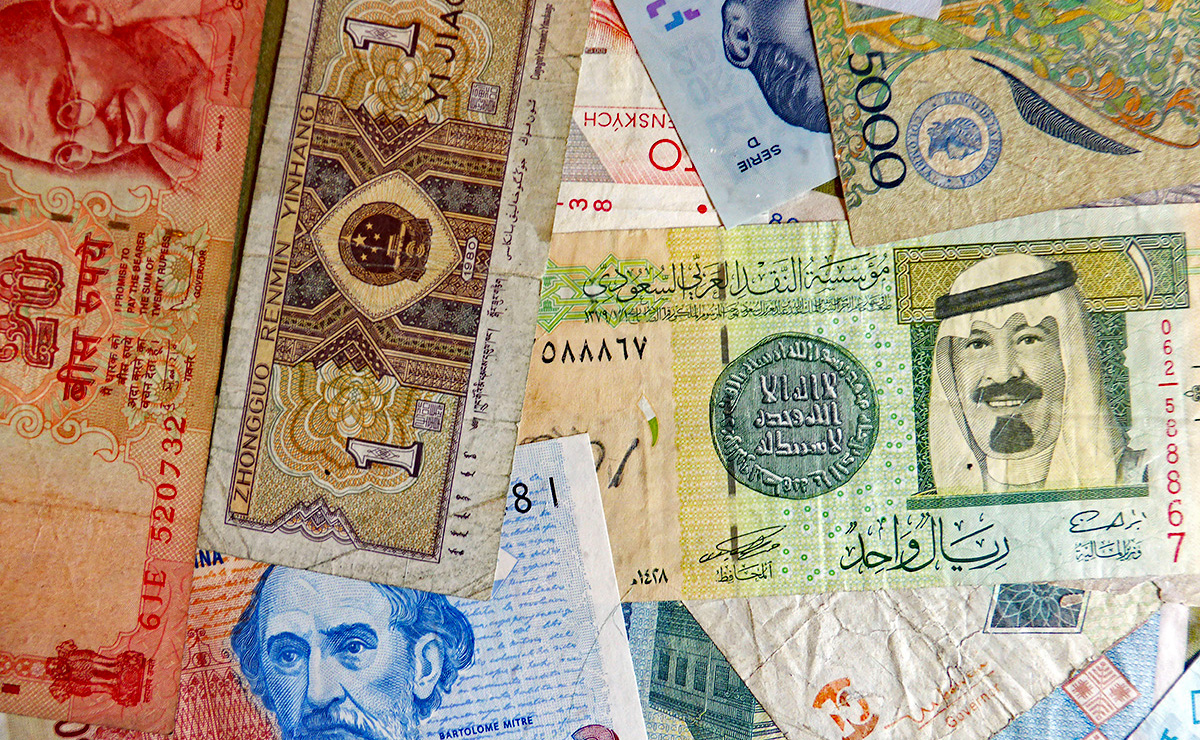 Inflation has been rising around the world as a combination of a recovery in demand and supply-chain issues have resulted in aggregate demand exceeding aggregate supply. Annual consumer price inflation at the beginning of 2022 is around 2.5% in China, 3.5% in Sweden, 5% in the eurozone, Canada and India, 6% in the UK and South Africa, 7% in the USA and 7.5% in Mexico. In each case it is forecast to go a little higher before falling back again.
Inflation has been rising around the world as a combination of a recovery in demand and supply-chain issues have resulted in aggregate demand exceeding aggregate supply. Annual consumer price inflation at the beginning of 2022 is around 2.5% in China, 3.5% in Sweden, 5% in the eurozone, Canada and India, 6% in the UK and South Africa, 7% in the USA and 7.5% in Mexico. In each case it is forecast to go a little higher before falling back again.
Inflation in Turkey
In Turkey inflation is much higher. The official annual rate of consumer price inflation in December 2021 was 36.1%, sharply up from 21.3% in November. But according to Turkey’s influential ENAGrup the December rate was much higher still at 82.8%. Official producer price inflation was 79.9% and this will feed through into official consumer price inflation in the coming weeks.
The rise in inflation has hit the poor particularly badly. According to the official statistics, in the year to December 2021, domestic energy prices increased by 34.2%, food by 44.7% and transport by 53.7%. In response, the government has raised the minimum wage by nearly 50% for 2022.
Causes of high and rising inflation
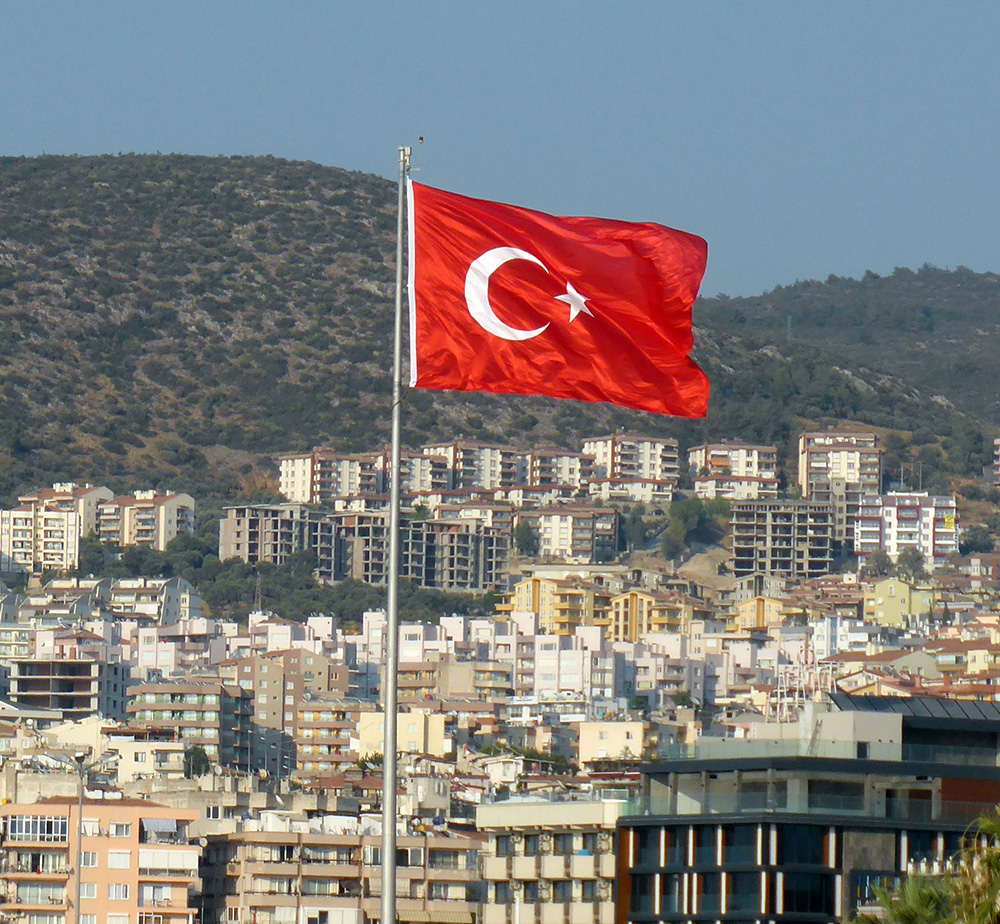 Why is Turkey’s inflation so much higher than in most developed and emerging economies and why has it risen so rapidly? The answer is that aggregate demand has been excessively boosted – well ahead of the ability of supply to respond. This has driven inflation expectations.
Why is Turkey’s inflation so much higher than in most developed and emerging economies and why has it risen so rapidly? The answer is that aggregate demand has been excessively boosted – well ahead of the ability of supply to respond. This has driven inflation expectations.
Turkey’s leader, President Erdoğan, in recent years has been seeking to stimulate economic growth through a mixture of supply-side, fiscal and monetary policies. He has hoped that the prospect of high growth would encourage both domestic and inward investment and that this would indeed drive the high growth he seeks. To encourage investment he has sought to reduce the reliance on imports through various measures, such as public procurement favouring domestic firms, tax reliefs for business and keeping interest rates down. He has claimed that the policy is focused on investment, production, employment and exports, instead of the ‘vicious circle of high interest rates and low exchange rates’.
With the pandemic, fiscal policy was largely focused on health, social security and employment measures. Such support was aided by a relatively healthy public finances. General government debt was 32% of GDP in 2020. This compares with 74% for the EU and 102% for the G7. Nevertheless, the worsening budget deficit has made future large-scale expenditure on public infrastructure, tax cuts for private business and other supply-side measures more difficult. Support for growth has thus fallen increasingly to monetary policy.
The Turkish central bank is not independent, with the President firing senior officials with whom he disagrees over monetary policy. The same applies to the Finance Ministry, with independently-minded ministers losing their jobs. Monetary and exchange rate policy have thus become the policy of the President. And it is here that a major part of the current problem of rising inflation lies.
Monetary and exchange rate policy
Despite rising inflation, the central bank has reduced interest rates. At its monthly meeting in September 2021, the Turkish central bank reduced its key rate from 19% to 18% and then to 16% in October, to 15% in November and 14% in December. These unprecedented rate cuts saw a large increase in the money supply. M1 rose by 11.7% in November alone; the annual growth rate was 59.5%. Broad money (M2 and M3) similarly rose. M3 grew by an annual rate of 51% in November 2021. The cut in interest rates and rise in money supply led to a rise in nominal expenditure which, in turn, led to higher prices.

The cut in interest rates and rise in nominal aggregate demand led to a large depreciation in the exchange rate. On 1 September 2021, 100 Turkish lira exchanged for $12.05. By 11 January 2022 the rate had fallen to $7.22 – a 40.1% depreciation. This depreciation, in turn, further stoked inflation as the lower exchange rate pushed up the price of imported goods. (Click here for a PowerPoint of the chart.)
Attempts were made to stem this fall in the lira on 20 December, by which point 100 lira were trading for just $5.50 (see chart) and speculation against the lira was gathering momentum. President Erdoğan announced a scheme to protect lira deposits against currency volatility, guaranteeing lira deposits in hard currency terms. The mechanism adopted was a rise in the interest rate on lira deposits with a maturity of 3 to 12 months, thereby encouraging people to lock in deposits for the medium term and not, therefore, to use them to speculate against the lira by buying other currencies. Other interest rates would be unaffected. At the same time the central bank used foreign currency reserves to engage in large-scale purchases of the lira on the foreign exchange market.
The lira rallied. By 23 December, 100 lira were trading for $8.79. But then selling of the lira began again and, as stated above, by early January 100 lira had fallen to $7.22. The underlying problem of excess demand and high inflationary expectations had not been solved.
It remains to be seen whether the President will change his mind and decide that the central bank needs to raise interest rates to reduce inflation and restore confidence.
Videos
Articles
- Turkish Inflation Hits Highest Since 2002 Amid Lira Woes
Bloomberg, Baris Balci and Cagan Koc (3/1/22)
- Turkey’s annual inflation rate is over 82 percent, finds research group
Bianet (3/1/22)
- How Turkey can overcome its economic challenges
Arab News, Zaid M Belbagi (2/1/22)
- Turkey cuts interest rates despite spiralling inflation
BBC News, Victoria Craig (16/12/21)
- Turkey inflation surges 36% amid lira crisis, highest since 2002
CNBC (3/1/22)
- Turkey mulls new financial instruments to shield against inflation
Daily Sabah (3/1/22)
- Turkey raises minimum wage as lira crash, inflation sow hardship
Aljazeera, Umar Farooq (16/12/21)
- What to make of Turkey’s latest unorthodox currency move
Financial Times, Mohamed El-Erian (21/12/21)
- Erdoğan gambles on economy amid protests and rocketing inflation
The Guardian, Phillip Inman (24/11/21)
- Explained: How did Turkey’s economy go so wrong?
The Indian Express, Patricia Cohen (15/12/21)
Data
Questions
- Until the pandemic, the Turkish economy could be seen as a success story. Why?
- What supply-side policies did Turkey pursue?
- Use either an aggregate demand and supply diagram or a dynamic aggregate demand and supply (DAD/DAS) diagram to explain what has happened to inflation in Turkey in the past few months.
- Explain the thinking behind the successive cuts in interest rates since September 2021.
- Why did the measures introduced on 20 December 2021 only temporarily halt the depreciation of the lira?
- Choose a country with a higher rate of inflation than Turkey (see second data link above). Find out the causes of its high rate. Are they similar to those in Turkey?
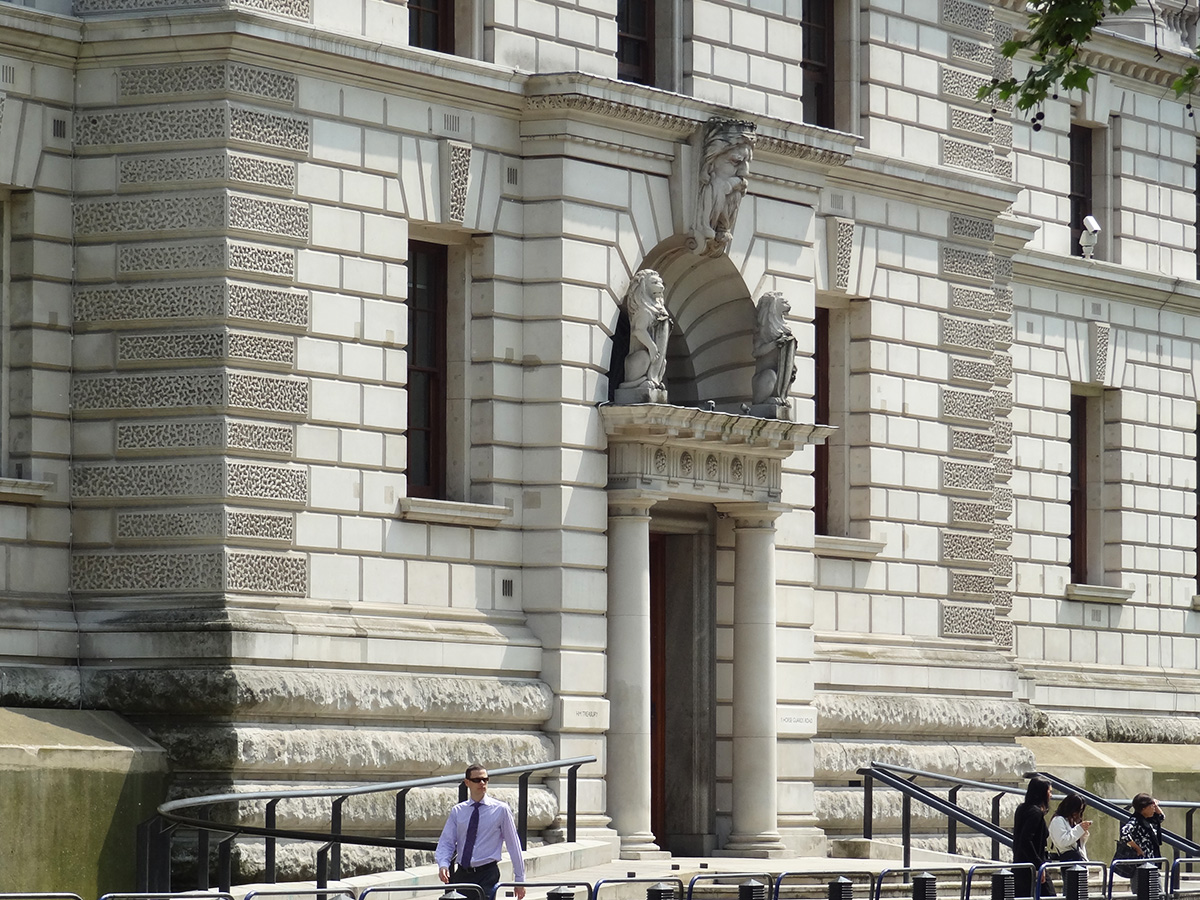 The UK government has made much of its spending commitments in the UK Budget and Spending Review delivered on 27 October 2021. Spending on transport infrastructure, green energy and health care figured prominently. The government claimed that these were to help achieve its objectives of economic growth, carbon reduction and ‘levelling up’. This means that government expenditure will be around 42% of GDP for the five years from 2022 (from 1988 to 2000 it averaged 36%). Although it temporarily rose to 52% in 2020/21, this was the result of supporting the economy through the pandemic. But does this mean that the government is now a ‘Keynesian’ one?
The UK government has made much of its spending commitments in the UK Budget and Spending Review delivered on 27 October 2021. Spending on transport infrastructure, green energy and health care figured prominently. The government claimed that these were to help achieve its objectives of economic growth, carbon reduction and ‘levelling up’. This means that government expenditure will be around 42% of GDP for the five years from 2022 (from 1988 to 2000 it averaged 36%). Although it temporarily rose to 52% in 2020/21, this was the result of supporting the economy through the pandemic. But does this mean that the government is now a ‘Keynesian’ one?
When the economy is in recession, as was the case in 2020 with the effects of the pandemic, increased government expenditure financed by borrowing rather than taxation is the classic Keynesian remedy to boost aggregate demand and close the output gap. The increased injection of spending works through the multiplier process to raise equilibrium national income and reduce unemployment.
But is this the objective of the extra spending announced in October 2021? To answer this, it is important to look at forecasts for the state of the economy with no change in government policy and at the balance of government expenditure and taxation resulting from the Budget. The first chart shows public sector net borrowing from 2006/7 and forecast to 2026/7. The green and red lines from 2021/22 onwards give the PSNB forecasts with and without the October 2021 measures.
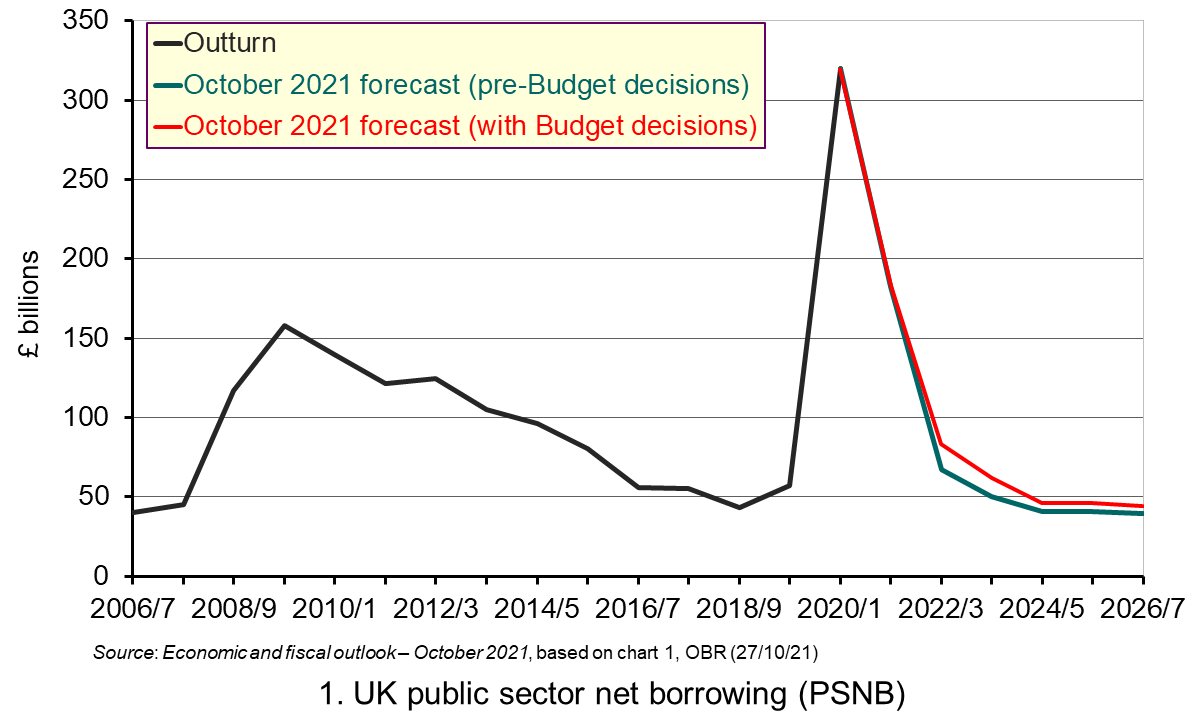 As you can see, there was a large increase in the PSNB in 2020/21, reflecting the government’s measures to support firms and workers during the pandemic. (Click here for a PowerPoint of the chart.) This was very much a Keynesian response, where a large budget deficit was necessary to support aggregate demand. It was also to protect the supply side of the economy by enabling firms to survive.
As you can see, there was a large increase in the PSNB in 2020/21, reflecting the government’s measures to support firms and workers during the pandemic. (Click here for a PowerPoint of the chart.) This was very much a Keynesian response, where a large budget deficit was necessary to support aggregate demand. It was also to protect the supply side of the economy by enabling firms to survive.
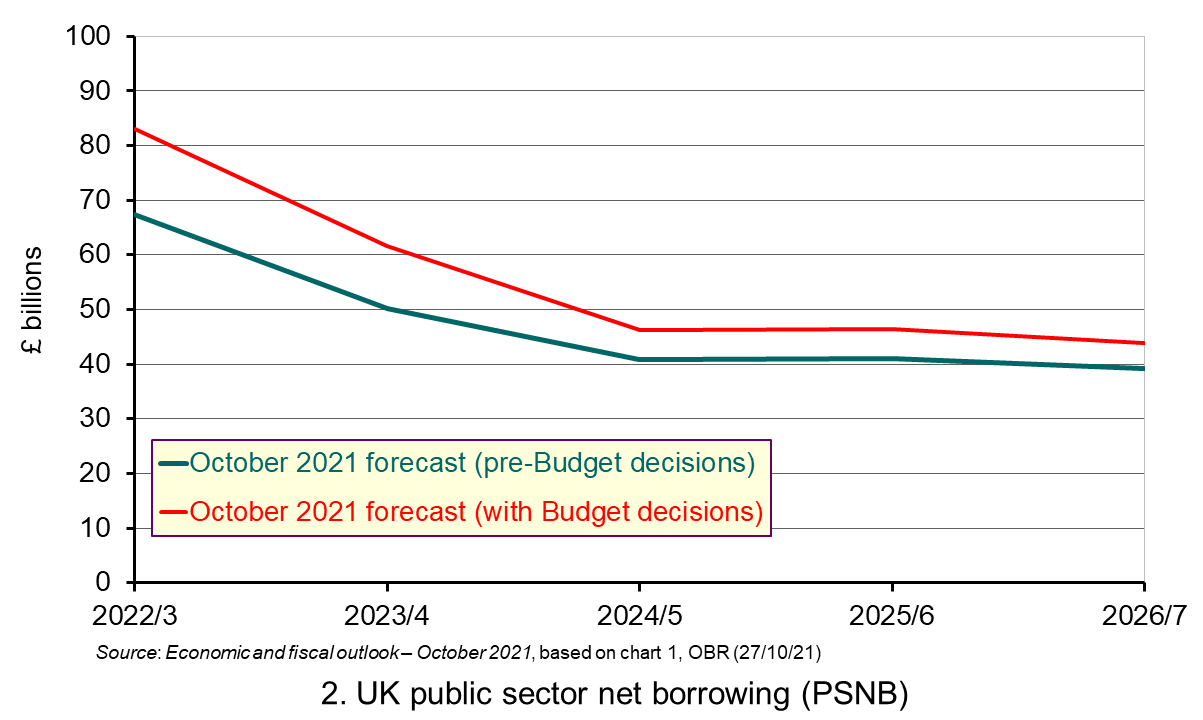 But could the October 2021 announcements also be seen as a Keynesian response to the macroeconomic situation? If we redraw Chart 1, focusing just on the forecast period and adjust the vertical scale, we can see that the measures have a net effect of increasing the PSNB and thus acting as a stimulus to aggregate demand. (Click here for a PowerPoint of the chart.) The figures are shown in the following table, which shows the totals from Table 5.1 in the Autumn Budget and Spending Review 2021 document:
But could the October 2021 announcements also be seen as a Keynesian response to the macroeconomic situation? If we redraw Chart 1, focusing just on the forecast period and adjust the vertical scale, we can see that the measures have a net effect of increasing the PSNB and thus acting as a stimulus to aggregate demand. (Click here for a PowerPoint of the chart.) The figures are shown in the following table, which shows the totals from Table 5.1 in the Autumn Budget and Spending Review 2021 document:
Effects of Spending Review and Budget 2021 on PSNB (+ = increase in PSNB)

At first sight, it would seem that the Budget was mildly expansionary. To see how much so, the Office for Budget Responsibility (OBR) measures the ‘fiscal stance’ using the ‘cyclically adjusted primary deficit (CAPD)’. This is PSNB minus interest payments and minus expenditures and tax revenues that fluctuate with the cycle and which therefore act as automatic stabilisers. The OBR’s forecast of the CAPD shows it to be expansionary, but decreasing over time. In 2021/22, there is forecast to be a net injection of around 3.2% (excluding ‘virus-related’ support), falling to 2.7% in 2022/23 and then gradually to around 0.6% by 2026/27. So it does seem that fiscal policy remains expansionary throughout the period, but less and less so.
But this alone does not make it ‘Keynesian’. A Keynesian Budget would be one that uses fiscal policy to adjust aggregate demand (AD) according to whether AD is forecast to be deficient or excessive without the Budget measures. To operate a Keynesian Budget, it would be necessary to forecast the output gap without any policy measures. If was forecast to be negative (a deficiency of demand, with equilibrium output below the potential level), then an expansionary policy should be pursued by raising government expenditure, cutting taxes or some combination of the two. If it was forecast to be positive (an excess demand, with equilibrium output above the potential level), then a contractionary/deflationary policy should be pursued by cutting government expenditure, raising taxes or some combination of the two.
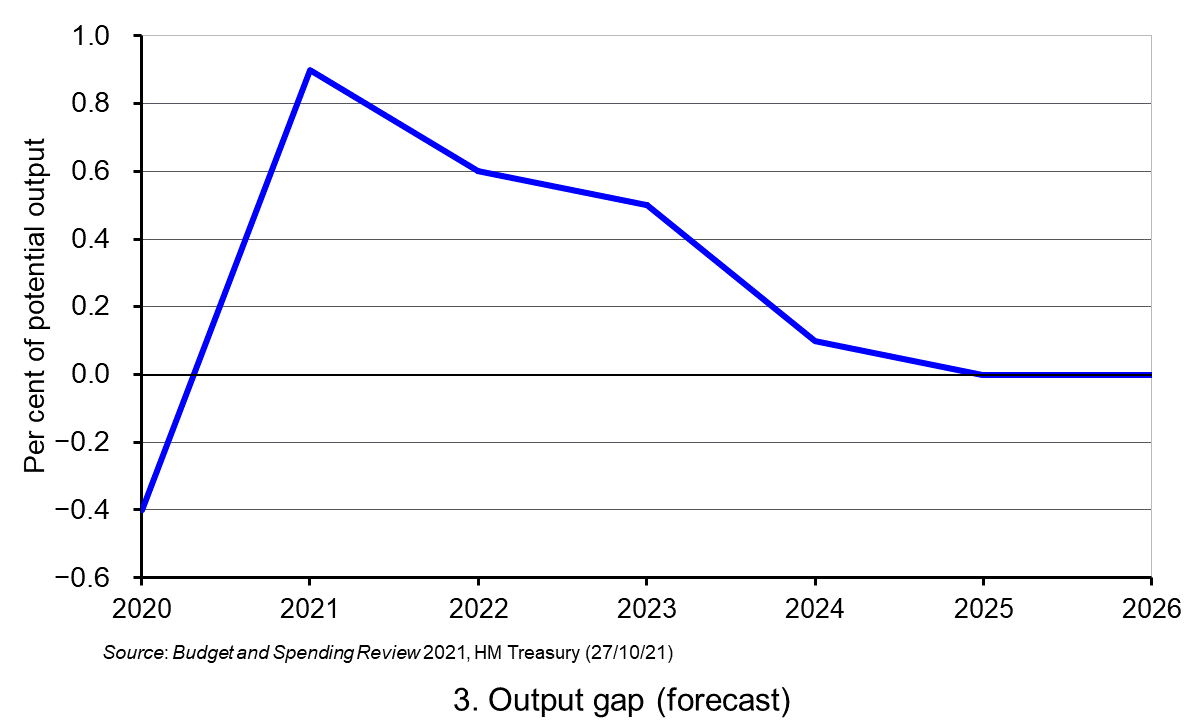 So what is the forecast for the output gap? The OBR states that, after being negative in 2020
So what is the forecast for the output gap? The OBR states that, after being negative in 2020
(–0.4% of potential GDP), it has risen substantially to 0.9% in 2021 with the rapid bounce back from the pandemic. But it is forecast to remain positive, albeit declining, until reaching zero in 2025. This is illustrated in Chart 3. (Click here for a PowerPoint of the chart.) So fiscal policy remains mildly expansionary until 2025, after having provided a considerable stimulus in 2021.
This is not normally what a Keynesian economist would recommend. Fiscal policy should be designed to achieve a zero output gap. With the output gap being substantially positive in 2021, there is a problem of excess demand. This can be seen in supply-chain difficulties and labour shortages in certain areas and higher inflation, with CPI inflation predicted by the OBR to rise to 4.4 per cent in 2022. The combination of higher prices, the rise in national insurance from April 2022 by 1.25 percentage points and the freezing of income tax personal allowances will squeeze living standards. And the cancelling of the £20 per week uplift to Universal Credit and no increase in its rate for the unemployed will put particular pressure on some of the poorest people.
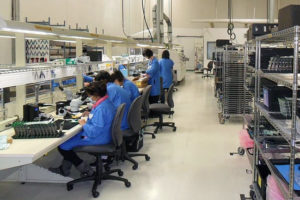 The government is hoping that the rise in government expenditure will have beneficial supply-side effects and increase potential national income. The aim is to create a high-wage, high-skilled, high-productivity economy though investment in innovation, infrastructure and skills. As the OBR states, ‘The rebounding economy has provided the Chancellor with a Budget windfall that he has added to with tax rises that lift the tax burden to its highest since the early 1950s’.
The government is hoping that the rise in government expenditure will have beneficial supply-side effects and increase potential national income. The aim is to create a high-wage, high-skilled, high-productivity economy though investment in innovation, infrastructure and skills. As the OBR states, ‘The rebounding economy has provided the Chancellor with a Budget windfall that he has added to with tax rises that lift the tax burden to its highest since the early 1950s’.
It remains to be seen whether the extra spending on education, training, infrastructure and R&D will be sufficient to achieve the long-term growth the Chancellor is seeking. The OBR is forecasting very modest growth into the longer term when the bounce back has worked through. Real GDP is forecast to grow on average by just 1.5% per year from 2024 to 2026. What is more, the OBR sees permanent scarring effects of around 2% of GDP from the pandemic and around 4% of GDP from Brexit.
Articles
Analysis
Documents
Data
Questions
- What do you understand by ‘fiscal stance’?
- What are ‘automatic fiscal stabilisers? How might they affect GDP over the next few years?
- If the government had chosen to pursue a zero output gap from 2022/23 onwards, how would this have affected the balance between total government expenditure and taxation in the 2021 Budget and Spending Review?
- Provide a critique of the Budget from the left.
- Provide a critique of the budget from the right.
- Was this a ‘Green Budget’?
- Is the Budget following the ‘golden rule’ of fiscal policy?
- Look through Table 5.1 in the Budget and Spending Review document (linked below). Which of the measures will have the most substantial effect on aggregate demand?
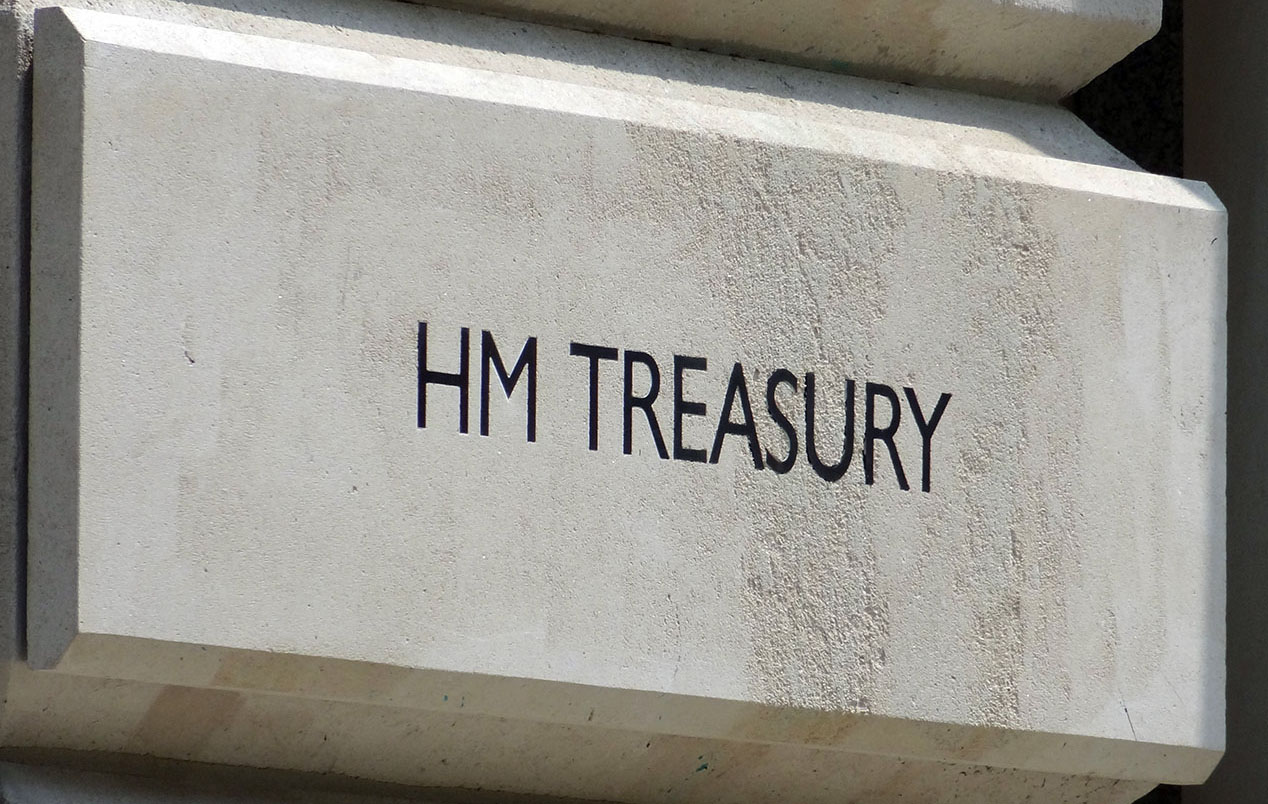 The COVID-19 pandemic had a stark effect on countries’ public finances. Governments had to make difficult fiscal choices around spending and taxation to safeguard public health, and the protection of jobs and incomes both in the present and in the future. The fiscal choices were to have historically large effects on the size of public spending and on the size of public borrowing.
The COVID-19 pandemic had a stark effect on countries’ public finances. Governments had to make difficult fiscal choices around spending and taxation to safeguard public health, and the protection of jobs and incomes both in the present and in the future. The fiscal choices were to have historically large effects on the size of public spending and on the size of public borrowing.
Here we briefly summarise the magnitude of these effects on public spending, receipts and borrowing in the UK.
The public sector comprises both national government and local or regional government. In financial year 2019/20 public spending in the UK was £886 billion. This would rise to £1.045 trillion in 2020/21. To understand better the magnitude of these figures we can express them as a share of national income (Gross Domestic Product). In 2019/20 public spending was 39.8 per cent of national income. This rose to 52.1 per cent in 2020/21. Meanwhile, public-sector receipts, largely taxation, fell from £829.1 billion in 2019/20 to £796.5 billion in 2020/21, though, because of the fall in national income, the share of receipts in national income rose very slightly from 37.3 to 37.9 per cent of national income.
The chart shows both public spending and public receipts as a share of national income since 1900. (Click here for a PowerPoint of the chart.) What this chart shows is the extraordinary impact of the two World Wars on the relative size of public spending. We can also see an uptick in public spending following the global financial crisis and, of course, the COVID-19 pandemic. The chart also shows that spending is typically larger than receipts meaning that the public sector typically runs a budget deficit. 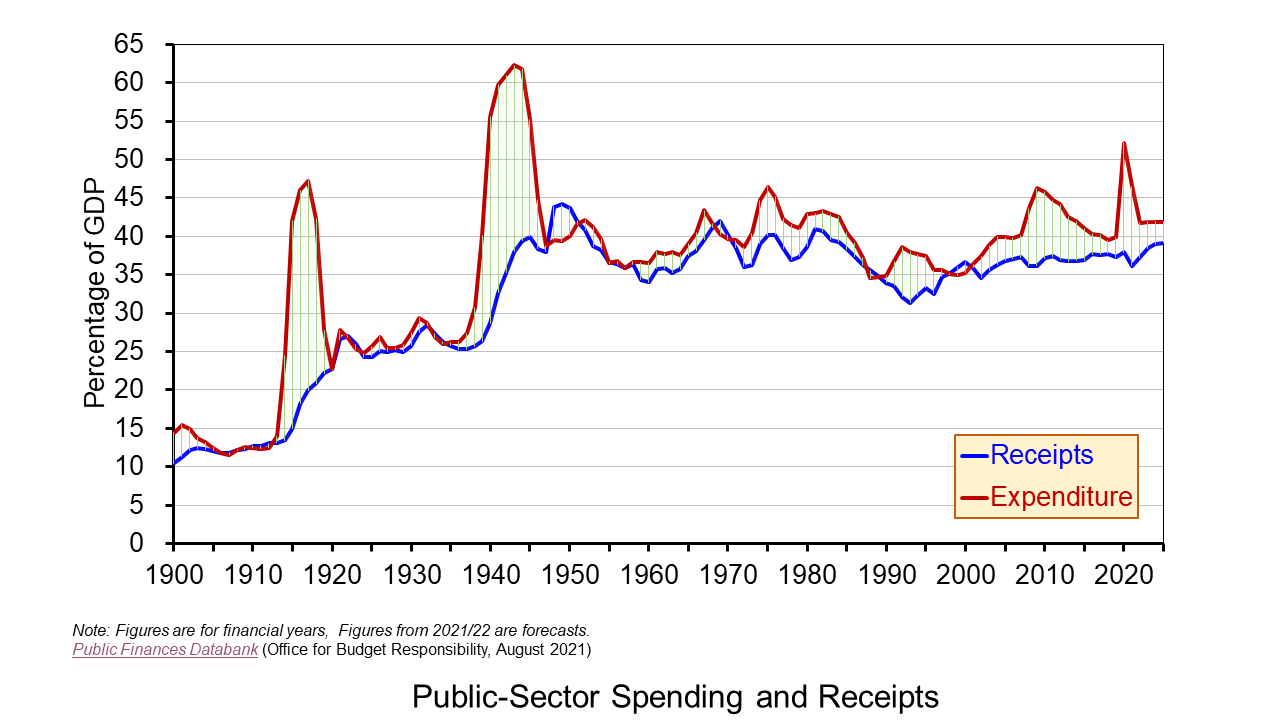 .
.
If we focus on public spending as a share of national income and its level following the two world wars, we can see that it did not fall back to pre-war levels. This is what Peacock and Wiseman (1961) famously referred to as a displacement effect. They attributed this to, among other things, an increase in the public’s tolerance to pay higher taxation because of the higher taxes levied during the war as well as to a desire for greater public intervention. The latter arose from an inspection effect. This can be thought of as a public consciousness effect, with the war helping to shine a light on a range of economic and social issues, such as health, housing and social security. These two effects, it is argued, reinforced each other, allowing the burden of taxation to rise and, hence, public spending to increase relative to national income.
If we forward to the global financial crisis, we can again see public spending rise as a share of national income. However, this time the ratio did not remain above pre-crisis levels. Rather, the UK government was fearful of unsustainable borrowing levels and the crowding out of private-sector activity by the public sector, with higher interest rates making public debt an attractive proposition for investors. It thus sought to reduce the public-sector deficit by engaging in what became known as ‘austerity’ measures.
 If we move forward further to the COVID-19 pandemic, we see an even more significant spike in public spending as a share of national income. It is of course rather early to make predictions about whether the pandemic will have enduring effects on public spending and taxation. Nonetheless the pandemic, in a similar way to the two world wars, has sparked public debates on many economic and social issues. Whilst debates around the funding of health and social care are longstanding, it could be argued that the pandemic has provided the government with the opportunity to introduce the 1.25 percentage point levy from April 2022 on the earned incomes of workers (both employees and the self-employed) and on employers. (See John’s blog Fair care? for a fuller discussion on the tax changes to pay for increased health and social care expenditure).
If we move forward further to the COVID-19 pandemic, we see an even more significant spike in public spending as a share of national income. It is of course rather early to make predictions about whether the pandemic will have enduring effects on public spending and taxation. Nonetheless the pandemic, in a similar way to the two world wars, has sparked public debates on many economic and social issues. Whilst debates around the funding of health and social care are longstanding, it could be argued that the pandemic has provided the government with the opportunity to introduce the 1.25 percentage point levy from April 2022 on the earned incomes of workers (both employees and the self-employed) and on employers. (See John’s blog Fair care? for a fuller discussion on the tax changes to pay for increased health and social care expenditure).
The extent to which there may be a pandemic displacement effect will depend on the fiscal choices made in the months and years ahead. The key question is how powerful will be the effect of social issues like income and wealth inequality, regional and inter-generational disparities, discrimination, poor infrastructure and educational opportunities in shaping these fiscal choices? Will these considerations carry more weight than the push to consolidate the public finances and tighten the public purse? These fiscal choices will determine the extent of any displacement effect in public spending and taxation.
Reference
Alan Peacock and Jack Wiseman, The Growth in Public Expenditure in the United Kingdom, Princeton University Press (1961).
Articles
Questions
- What do you understand by the term ‘public finances’?
- Why might you wish to express the size of public spending relative to national income rather than simply as an absolute amount?
- Undertake research to identify key pieces of social policy in the UK that were enacted at or around the times of the two World Wars.
- What do you understand by the terms ‘tolerable tax burden’ and ‘inspection effect’?
- Identify those social issues that you think have come into the spotlight as a result of the pandemic. Undertake research on any one of these and write a briefing note exploring the issue and the possible policy choices available to government.
- What is the concept of crowding out? How might it affect fiscal choices?
- How would you explain the distinction between public-sector borrowing and public-sector debt? Why could the former fall and the latter rise at the same time?
 As we saw in Part 1, households are seeing a rise in the cost of living, which is set to accelerate. Inflation in the year to January 2022, as measured by the Consumer Prices Index (CPI), was 5.5%, the highest rate for over 30 years, and it is expected to reach more than 7 per cent by April. This has put great pressure on household budgets, with wage rises for most people being below the rate of price inflation. The poor especially have been hard hit, with many struggling to meet soaring energy, food and transport prices and higher rents.
As we saw in Part 1, households are seeing a rise in the cost of living, which is set to accelerate. Inflation in the year to January 2022, as measured by the Consumer Prices Index (CPI), was 5.5%, the highest rate for over 30 years, and it is expected to reach more than 7 per cent by April. This has put great pressure on household budgets, with wage rises for most people being below the rate of price inflation. The poor especially have been hard hit, with many struggling to meet soaring energy, food and transport prices and higher rents. The Chancellor, Rishi Sunak, has stated that the government understands the pressures families are facing with the cost of living. However, rising interest rates mean that it will cost the Treasury considerably more to service the UK’s national debt of more than £2tn.
The Chancellor, Rishi Sunak, has stated that the government understands the pressures families are facing with the cost of living. However, rising interest rates mean that it will cost the Treasury considerably more to service the UK’s national debt of more than £2tn. The Bank of England’s traditional response to rising inflation is to raise interest rates, which it has done this twice in the past few months. This means that people who have borrowed money could see their monthly payments go up, especially on mortgages tied to Bank Rate.
The Bank of England’s traditional response to rising inflation is to raise interest rates, which it has done this twice in the past few months. This means that people who have borrowed money could see their monthly payments go up, especially on mortgages tied to Bank Rate. Rising inflation affects all our living standards. It a global issue with causes beyond government control.
Rising inflation affects all our living standards. It a global issue with causes beyond government control.  What should the government do about rising energy prices?
What should the government do about rising energy prices? With the onset of the pandemic in early 2020, stock markets around the world fell dramatically, with many indices falling by 30% or more. In the USA, the Dow Jones fell by 37% and the Nasdaq fell by 30%. In the UK, the FTSE 100 fell by 33% and the FTSE 250 by 41%.
With the onset of the pandemic in early 2020, stock markets around the world fell dramatically, with many indices falling by 30% or more. In the USA, the Dow Jones fell by 37% and the Nasdaq fell by 30%. In the UK, the FTSE 100 fell by 33% and the FTSE 250 by 41%.
 The key question is what will investors believe. If they believe that share prices will continue to fall they are likely to sell. This has happened since early January, especially in the USA and especially with stocks in the high-tech sector – such stocks being heavily represented in the Nasdaq composite, a broad-based index that includes over 2500 of the equities listed on the Nasdaq stock exchange. From 3 January to 18 February the index fell from 15 833 to 13 548, a fall of 14.4%. But will this fall be seen as enough to reflect the current economic and financial climate. If so, it could fluctuate around this sort of level.
The key question is what will investors believe. If they believe that share prices will continue to fall they are likely to sell. This has happened since early January, especially in the USA and especially with stocks in the high-tech sector – such stocks being heavily represented in the Nasdaq composite, a broad-based index that includes over 2500 of the equities listed on the Nasdaq stock exchange. From 3 January to 18 February the index fell from 15 833 to 13 548, a fall of 14.4%. But will this fall be seen as enough to reflect the current economic and financial climate. If so, it could fluctuate around this sort of level. But a lot of this is second-guessing what other people will do – known as a
But a lot of this is second-guessing what other people will do – known as a  Inflation has been rising around the world as a combination of a recovery in demand and supply-chain issues have resulted in aggregate demand exceeding aggregate supply. Annual consumer price inflation at the beginning of 2022 is around 2.5% in China, 3.5% in Sweden, 5% in the eurozone, Canada and India, 6% in the UK and South Africa, 7% in the USA and 7.5% in Mexico. In each case it is forecast to go a little higher before falling back again.
Inflation has been rising around the world as a combination of a recovery in demand and supply-chain issues have resulted in aggregate demand exceeding aggregate supply. Annual consumer price inflation at the beginning of 2022 is around 2.5% in China, 3.5% in Sweden, 5% in the eurozone, Canada and India, 6% in the UK and South Africa, 7% in the USA and 7.5% in Mexico. In each case it is forecast to go a little higher before falling back again. Why is Turkey’s inflation so much higher than in most developed and emerging economies and why has it risen so rapidly? The answer is that aggregate demand has been excessively boosted – well ahead of the ability of supply to respond. This has driven inflation expectations.
Why is Turkey’s inflation so much higher than in most developed and emerging economies and why has it risen so rapidly? The answer is that aggregate demand has been excessively boosted – well ahead of the ability of supply to respond. This has driven inflation expectations.
 The UK government has made much of its spending commitments in the UK Budget and Spending Review delivered on 27 October 2021. Spending on transport infrastructure, green energy and health care figured prominently. The government claimed that these were to help achieve its objectives of economic growth, carbon reduction and ‘levelling up’. This means that government expenditure will be around 42% of GDP for the five years from 2022 (from 1988 to 2000 it averaged 36%). Although it temporarily rose to 52% in 2020/21, this was the result of supporting the economy through the pandemic. But does this mean that the government is now a ‘Keynesian’ one?
The UK government has made much of its spending commitments in the UK Budget and Spending Review delivered on 27 October 2021. Spending on transport infrastructure, green energy and health care figured prominently. The government claimed that these were to help achieve its objectives of economic growth, carbon reduction and ‘levelling up’. This means that government expenditure will be around 42% of GDP for the five years from 2022 (from 1988 to 2000 it averaged 36%). Although it temporarily rose to 52% in 2020/21, this was the result of supporting the economy through the pandemic. But does this mean that the government is now a ‘Keynesian’ one? As you can see, there was a large increase in the PSNB in 2020/21, reflecting the government’s measures to support firms and workers during the pandemic. (Click
As you can see, there was a large increase in the PSNB in 2020/21, reflecting the government’s measures to support firms and workers during the pandemic. (Click  But could the October 2021 announcements also be seen as a Keynesian response to the macroeconomic situation? If we redraw Chart 1, focusing just on the forecast period and adjust the vertical scale, we can see that the measures have a net effect of increasing the PSNB and thus acting as a stimulus to aggregate demand. (Click
But could the October 2021 announcements also be seen as a Keynesian response to the macroeconomic situation? If we redraw Chart 1, focusing just on the forecast period and adjust the vertical scale, we can see that the measures have a net effect of increasing the PSNB and thus acting as a stimulus to aggregate demand. (Click 
 So what is the forecast for the output gap? The OBR states that, after being negative in 2020
So what is the forecast for the output gap? The OBR states that, after being negative in 2020 The government is hoping that the rise in government expenditure will have beneficial supply-side effects and increase potential national income. The aim is to create a high-wage, high-skilled, high-productivity economy though investment in innovation, infrastructure and skills. As the OBR states, ‘The rebounding economy has provided the Chancellor with a Budget windfall that he has added to with tax rises that lift the tax burden to its highest since the early 1950s’.
The government is hoping that the rise in government expenditure will have beneficial supply-side effects and increase potential national income. The aim is to create a high-wage, high-skilled, high-productivity economy though investment in innovation, infrastructure and skills. As the OBR states, ‘The rebounding economy has provided the Chancellor with a Budget windfall that he has added to with tax rises that lift the tax burden to its highest since the early 1950s’. The COVID-19 pandemic had a stark effect on countries’ public finances. Governments had to make difficult fiscal choices around spending and taxation to safeguard public health, and the protection of jobs and incomes both in the present and in the future. The fiscal choices were to have historically large effects on the size of public spending and on the size of public borrowing.
The COVID-19 pandemic had a stark effect on countries’ public finances. Governments had to make difficult fiscal choices around spending and taxation to safeguard public health, and the protection of jobs and incomes both in the present and in the future. The fiscal choices were to have historically large effects on the size of public spending and on the size of public borrowing. .
. If we move forward further to the COVID-19 pandemic, we see an even more significant spike in public spending as a share of national income. It is of course rather early to make predictions about whether the pandemic will have enduring effects on public spending and taxation. Nonetheless the pandemic, in a similar way to the two world wars, has sparked public debates on many economic and social issues. Whilst debates around the funding of health and social care are longstanding, it could be argued that the pandemic has provided the government with the opportunity to introduce the 1.25 percentage point levy from April 2022 on the earned incomes of workers (both employees and the self-employed) and on employers. (See John’s blog
If we move forward further to the COVID-19 pandemic, we see an even more significant spike in public spending as a share of national income. It is of course rather early to make predictions about whether the pandemic will have enduring effects on public spending and taxation. Nonetheless the pandemic, in a similar way to the two world wars, has sparked public debates on many economic and social issues. Whilst debates around the funding of health and social care are longstanding, it could be argued that the pandemic has provided the government with the opportunity to introduce the 1.25 percentage point levy from April 2022 on the earned incomes of workers (both employees and the self-employed) and on employers. (See John’s blog